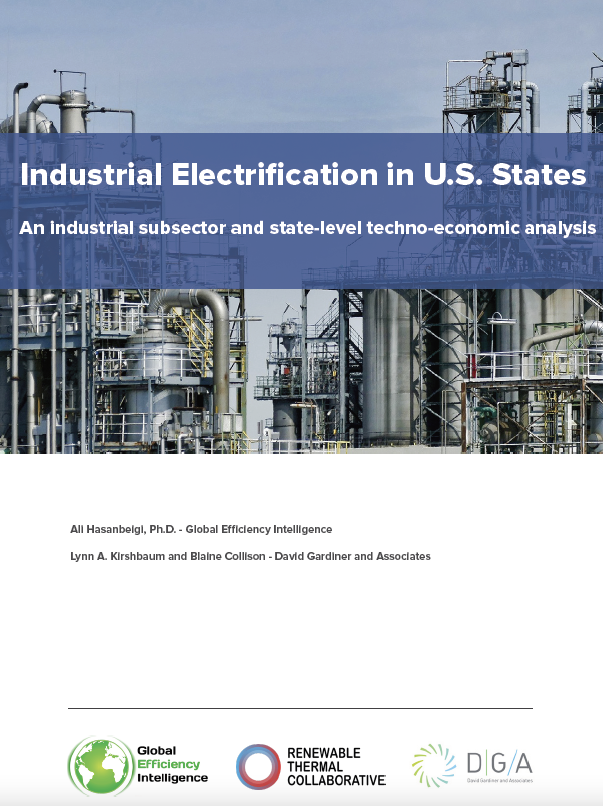Industrial Electrification in U.S. States
An industrial subsector and state-level techno-economic analysis
Authors: Ali Hasanbeigi, Ph.D. - Global Efficiency Intelligence
Lynn A. Kirshbaum and Blaine Collison - David Gardiner and Associates
The United States set an economy-wide target to reduce its net greenhouse gas (GHG) emissions to 50-52% below 2005 levels by 2030 and set a goal to reach 100% carbon pollution-free electricity by 2035. Meeting these goals will require a concentrated effort to develop and deploy clean technologies across sectors. The U.S.’s emissions reduction targets place a new emphasis on industrial emissions, highlighting the need for commercialization and deployment of cleaner industrial technologies. Unleashing US$369 billion in climate and clean energy incentives, the Inflation Reduction Act (IRA) provides powerful tailwinds for achieving these climate change mitigation targets.
States Factsheets
Alabama | California | Colorado | Florida
Georgia | Illinois | Indiana | Iowa
Kentucky | Louisiana | Michigan | Minnesota
North Carolina | Ohio | Oklahoma | Oregon
Pennsylvania | Texas | Washington | Wisconsin
The industrial sector accounts for about a quarter of energy use and GHG emissions in the U.S. While emissions from electricity generation continue to decline, thermal energy needs in industry, especially for process heating, are a significant challenge for climate change mitigation efforts.
There is a significant opportunity to decarbonize the industrial sector by shifting away from carbon-intensive fossil fuels to clean sources such as electrification, where low- or zero-carbon electricity is used. As can be seen in Figure 1, electrifying just the processes included in the study has the potential to realize significant emissions reductions throughout the country.
Figure 1. Change in emissions from select industrial process electrification in 2050 (Source: this study)
This report is a follow-up study to our previous report, “Electrifying U.S. Industry: A Technology- and Process-Based Approach to Decarbonization.” In the previous report, we studied industrial electrification potential at the national level. In this report, we analyze the electrification potential for 12 industries (aluminum casting, pulp and paper, container glass, ammonia, methanol, recycled plastic, steel, beer, beet sugar, milk powder, wet corn milling, and soybean oil) in 20 states.
The report identifies specific processes that could be electrified in the near term with commercially available technologies and analyzes the expected changes in energy use, CO2 emissions, and energy costs. Understanding which conventional processes could be electrified and how this impacts emissions and costs can help industrial facilities identify which of their processes may be suitable candidates for electrification. In addition, understanding the potential growth in industrial electricity demand that will result from electrification can help utilities, grid operators, and electricity generators plan for these changes and ensure equipment and generation resources are available to meet the growing demand for renewable electricity.
It should be noted that, in practice, electrification projects will happen at the plant level. If a given industrial facility in any state electrifies its process heating demand today and purchases renewable electricity (e.g., through a power purchase agreement (PPA)) to supply the electricity demand of the electrified process heating, the CO2 emissions reductions from electrification can be achieved immediately. Therefore, our state-level results that are based on expected grid-wide decarbonization timelines should not over-ride the immediate decarbonization impact of an electrified plant partnered with a new renewable energy purchase. Plants do not need to wait until the grid is decarbonized to have emissions reduction impacts.
Emissions reductions have global benefits, helping to mitigate climate risks and climate change impacts around the world. But reducing emissions has local benefits too. When industrial facilities use fossil fuels on-site, surrounding communities can be impacted by the resulting air pollution. In the U.S., low-income communities are often exposed to higher levels of air pollution across income levels, in urban and rural areas, and in all states. Industrial electrification offers an opportunity to reduce localized emissions and improve health outcomes for communities.
Electrifying industrial processes and realizing these benefits will require a multifaceted effort to solve significant challenges in renewable electricity generation and transmission, technology development and deployment, and workforce development. This report recommends six impactful changes that would support increased industrial electrification: 1) Support demonstration of emerging electrification technologies and new applications of existing technologies, 2) Financially incentivize electrification, 3) Increase renewable electricity generation capacity, 4) Enhance the electricity grid, 5) Engage communities, and 6) Develop the workforce.
To read the full report and see complete results and analysis of this new study, Download the full report from the link above.
A two-page factsheet for each state can also be downloaded from the links above.


